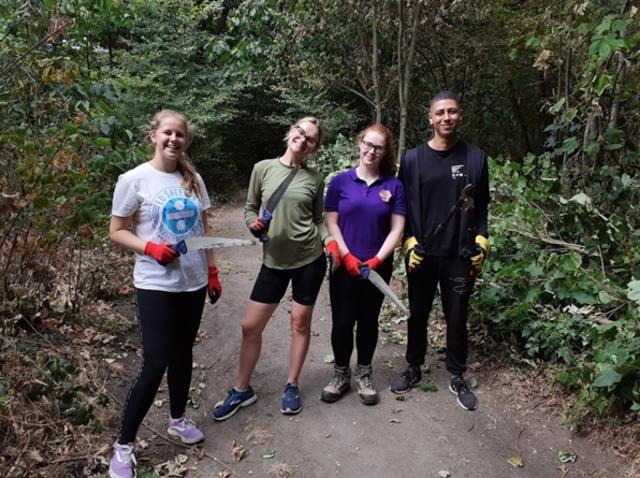Volunteering at Essex Country Parks to help encourage woodland growth
Tue, 23/08/2022 - 14:13

Members of Essex County Council’s Young Persons’ Network headed to Belhus Woods Country Park, giving young employees the opportunity to volunteer.
The volunteers spent time exploring the great outdoors and got involved with coppicing, creating brash hedges and trimming back woodland pathways in July.
Brash hedges are barriers made from branches and twigs. This is a way of using spare materials in a way which benefits eco-systems as it provides shelter for small mammals and birds, protecting them from predators and severe weather.
Young Sycamore trees were coppiced at Belhus Woods Country Park, which is managed by the Essex Country Parks team who work with many different volunteers from the local community as well as passionate employees from other teams in the Council.
Coppicing is the process of reducing trees in a set area to stumps and is done to improve the diversity of the woodland by encouraging fresh growth at ground level, creating structural diversity in a woodland and allowing sunlight to reach the woodland floor. The material cut can also create brash hedges to create more wildlife habitats.
Cllr Peter Schwier, Essex County Council Climate Czar, recently visited Tarecroft Wood near Witham, which had also recently been coppiced.
Cllr Schwier said: “I’m really pleased to see the successful work of the Essex Forest Initiative.
“Seeing the wildlife, such as the orchids which had previously laid dormant, is an incredible sight and it is made even better knowing that it has come as a direct result of the coppicing carried out.”
The Sycamore which was being coppiced at Belhus Woods was being cut early to reduce its vigorous growth. This will facilitate coppicing of Hazel and Sweet Chestnut in December. Winter is an ideal time to coppice as the sap in trees is down, which avoids the tree wasting energy and maximising new growth the following year.
The ancient management technique of coppicing encourages conditions for natural regeneration of trees and flowers whilst increasing biodiversity levels and creating new habitats for species of flower, bird, insect and mammal that might struggle in a tall forest.
To help maximise the benefits of coppicing it is done on a rotational basis. This encourages new vigorous growth from the stump which prevents the canopy permanently shading out ground-living plants and flowers.
It is a common technique used in conservation management of woodland as it replicates both the natural reaction of trees being impacted by large herbivores which no longer roam wild; and the natural spread and growth of woodland across the landscape which would be expected were this not restricted by modern agriculture and urbanisation.
Essex County Council’s Essex Forest Initiative looks to plant hundreds of thousands of new trees as well as care for and maintain the woodlands across the council's estate, working closely with the Essex Country Parks team among many other partners across the county.
The coppicing which took place in Belhus Woods Country Park will look to have a similar effect, increasing the biodiversity in the woods.
For any enquiries about volunteering with Essex County Parks, please email explore.essex@essex.gov.uk with the name of the park in the subject line. For more information about Essex Country Parks and Explore Essex please visit: www.explore-essex.com







